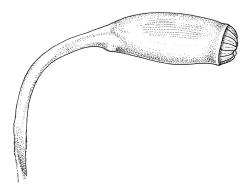Elements in the following description are taken from Ramsay et al. (2004).
Plants small, glossy, yellow-green, forming densely interwoven mats. Stems creeping, irregularly pinnate to bipinnate. Branches with erect, cuspidate tips. Branch and stem leaves similar, strongly falcate-secund to circinate, lanceolate to ovate-lanceolate, abruptly narrowed to an acuminate or long-acuminate apex that is sharply serrate, denticulate, or nearly entire and often twisted, entire below, strongly concave, clasping and sometimes sheathing at base, ecostate; mid laminal cells (upper third of leaf) elongate or linear, prorate or smooth, sometimes unipapillose; alar cells pigmented or hyaline, with c. 3 inflated, firm- to thick-walled cells in extreme angles and a few (one row?) small supra-alar cells. Costa lacking.
Autoicous. Perichaetia scattered on stems, the leaves oblong, strongly clasping, piliferous at apex. Setae elongate, slender, curved above, smooth or mammillate; twisted weakly to the left above in N.Z. species; capsules pendulous, horizontal or inclined, cylindric or oblong-cylindric, smooth, contracted below the mouth when dry, sometimes with strongly protuberant-mammillate neck (as in N.Z. species); stomata few, restricted to neck; annulus lacking in N.Z. species; operculum rostrate from a conic base, oblique or straight; exothecial cells mostly rectangular or oblong, often arranged in distinct longitudinal ranks, with the longitudinal walls thicker than the transverse walls, less often weakly collenchymatous. Peristome double; exostome teeth pale yellow-brown, with median zig-zag line on outer surface, lanceolate, not shouldered, appendiculate at margins but not otherwise bordered, transversely striate below, coarsely warty above, trabeculate on inner surface; endostome with a high basal membrane, the segments ± equal the teeth, strongly keeled, narrowly perforate; cilia single or double, well-developed, nodose. Calyptra enclosing the entire capsule, mitrate when immature, splitting and becoming cucullate, smooth, laciniate or entire at base. Spores finely papillose.
Warburgiella is a genus of about ten species distributed in Africa, Malesia, and Oceania. The type species, W. cupressinoides Müll.Hal., is from New Guinea.
Ramsay et al. (2004, p. 54) emphasised the subcollenchymatous exothecial cells, and the sheathing and expanded base of the inner perichaetial leaves with an abruptly acuminate or cuspidate apex, as defining features of this genus. They also cited (p. 57) the "peculiar capsule base" (which is irregularly protuberant-mammillate when dry, with stomata each situated at the apex of a protuberance) and the "rugulose" setae of this species as reason for transferring it to Warburgiella.
Fleischer (1923, p. 1249) provided a generic description (in German) and information about the four species he considered to occur in Java.
| Category | Number |
|---|---|
| Indigenous (Non-endemic) | 1 |
| Total | 1 |




